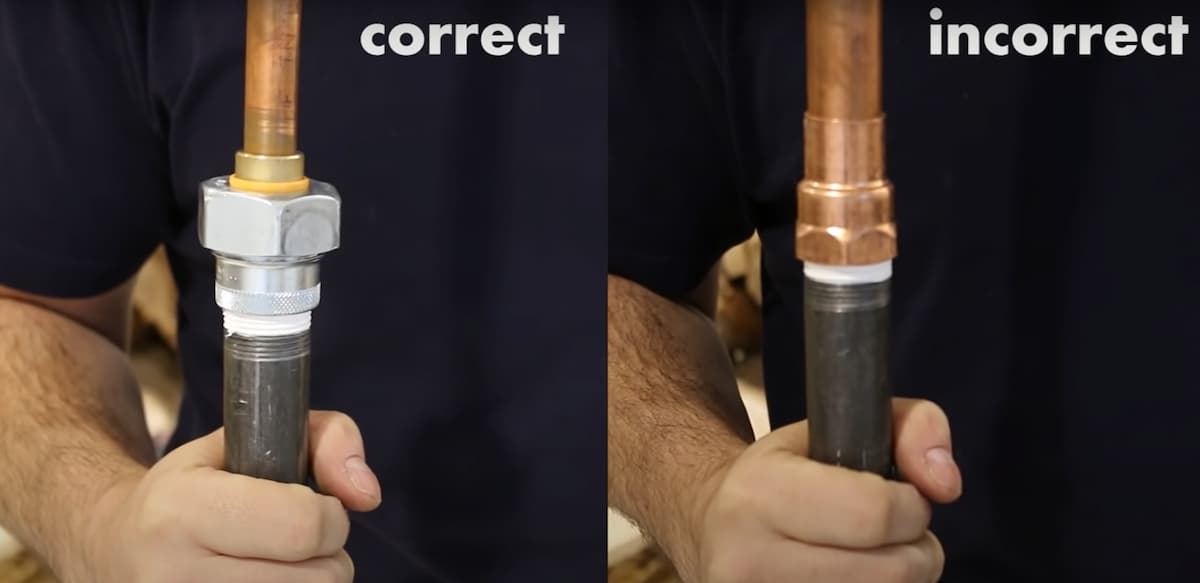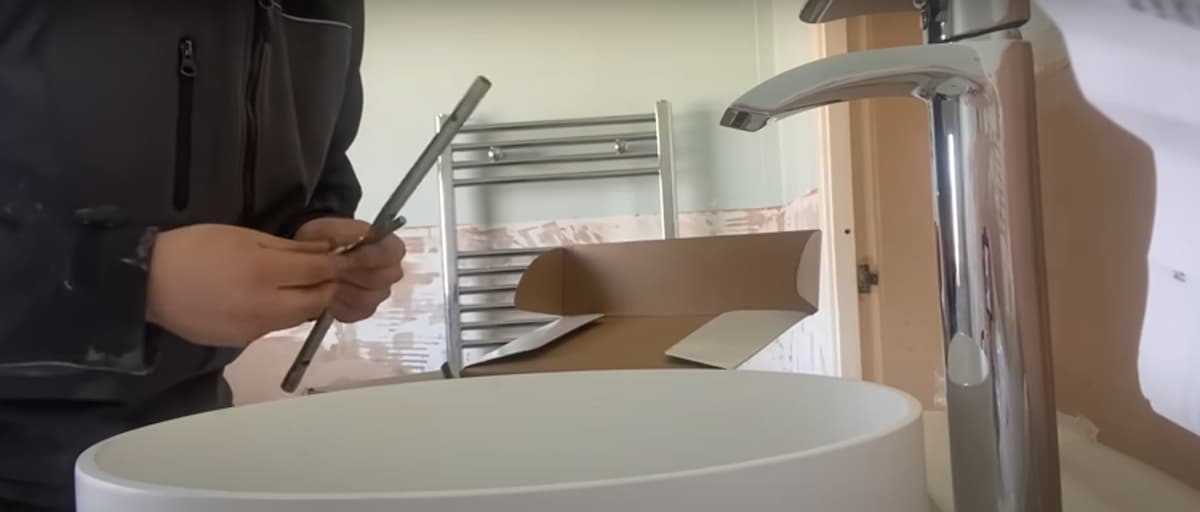
A plumbing snake, also known as a drain auger, is a long metal rod with a hand crank and rotating auger at one end and some form of grip at the other that’s sometimes called an eel. Plumbers use a plumbing snake to open drains that have been clogged with debris, most commonly hair and soap scum. A plumber may turn the crank on the end of the metal rod, which causes the auger to spin inside the drainpipe. The spinning motion of the spiral auger either dislodges or breaks apart whatever is stuck in the drainpipe, allowing water to flow freely again.
What is a Plumbing Drain Snake Used for?
Plumbing snakes are only used on drains that have been clogged with non-solid objects like hair, soap scum and food scraps. The spinning motion cannot break apart solids, so a plumbing snake is not meant to be used on drains that have been completely clogged by solid objects like baby toys or other items made of plastic. Those kinds of blockages require different equipment to remove the object itself. If you suspect your drain has been blocked by something solid, press down firmly on it before turning anything else on. If it stays firm, there may be an object sitting in the way of passing fluid.
A plumbing snake can save time if you’re dealing with a clog that doesn’t require you to remove any solid objects. If your drain is flowing properly but smells bad due to trapped accumulation of organic contaminants like dirt, soap scum or hair, then a plumbing snake can also save you money by not requiring an immediate call for a plumber. However, if the blockage has been caused by something solid instead of just organic gunk, using a plumbing snake on it may only push the object further down into the drainpipe.
Cheap Plumber’s Snake
Some cheap models simply screw apart as you crank them down the pipe and are therefore useless after one use. More expensive models have detachable shafts so they can be replaced once they wear out from being repeatedly extended and collapsed while working inside the drainpipe.
Where is a Drain Snake Used?
A drain snake is used to unblock drains. It’s most commonly used by plumbers to clear bathroom sink drains but they’re also used for blocked kitchen sinks, blocked shower drains and blockages in any other kind of drains like the ones on washing machines or dishwashers. A plumber’s snake can also be used to clear drains in toilets, although you could only use them if the toilet bowl is overflowing since using a snake can cause nasty water spills.

How to Use a Plumbing Snake?
A plumbing snake is used by rotating the attached crank which operates the auger head inside the drainpipe. The auger in turn spins and breaks apart whatever material has been clogging your drainpipe. If you’re using a metal snake, it may be much easier if you spray lubricant in your sink before turning on the water in order to prevent damage to its surface.
Ensure that the power is off before inserting the snakes into the drain, otherwise, you could end up with an electrical shock.
Insert one or two claws of the tongs into the end of the snake until they are snug against the barbs on its body. Many augers have teeth called spurs which are located in front of these claws and serve to pierce tougher clogs. The size, type and number of spurs vary widely depending on whether it’s meant for toilets or sinks. If your drains are slow-moving but not completely stopped up, you could only need one claw in order to grab hold of something inside them without having to cut it in half first. This is particularly useful when dealing with hair clogs.
The Difference between a Drain Aerator and a Plumber’s Snake?
A drain aerator is simply a device that attaches to the end of your faucet spout which disperses water into thin streams rather than one large spray. It’s slightly different from a plumber’s snake since it doesn’t actually unblock drains but instead improves rinsing power if you have hard water or chemicals in your tap water. The spurs on augers are much finer than those of aerators so it takes more effort if you want to cut through thick chunks of organic matter like dirt, hair or soap scum.
Some people prefer using an auger head because they don’t like the idea of their snakes breaking apart things that might be inside their drains (like kitchen scraps), although this isn’t really necessary since plumber’s snakes can easily remove these objects without harming them. However, you might want to consider a plumber’s snake if your drains are being clogged repeatedly because it is cheaper and simpler to replace than an auger.
In conclusion, a drain snake helps you clear out the blockage in your pipe quickly and efficiently without the need for professional help. It is most often used on bathroom sinks but can also be used for kitchen sinks or any other kind of drainpipe. A plumbing snake may not push solid objects further down into the drainpipe so it is generally safe for use on anything that has been flushed down toilets that don’t have metal bars across their openings especially if they’re overflowing with water since this gives you more time before flooding takes place.
How to Use a Drain Snake on other Clogs?
Other than using a drain auger to unblock a clogged drainpipe, you can also use it to break apart difficult clogs in your toilet or sinks even if they’re made of metal. This is particularly the case if the clog has been there for a while and maybe corroded because plunging can damage older pipes over time.
Making sure that the power is off before inserting the snakes into your drainpipe may help prevent any electrical accidents which might cause injuries or fires and ensure their effectiveness and avoid unnecessary damage to your plumbing system. To make things easier when dealing with thicker clogs, try spraying lubricants onto your sink beforehand to protect its surface from scratches by the claws of plumber’s snakes.
A drain aerator serves a different function than a plumber’s snake but is also used to unclog blocked drains. Its purpose is to improve rinsing power when using faucet water that has chemicals in it or extremely hard water. An auger can also break apart any organic matter that may be inside your drains, unlike aerators. A plumber’s snake could only be used on slow-moving bathroom or kitchen sink drain without metal bars across them in order to prevent damaging solid objects unnecessarily while an auger is preferable if you are facing clogs repeatedly which are corroded with time due to the lower cost of replacing augers rather than snakes when they wear out.
Using a Plumber’s Snake for a P-trap Toilet?
If you have a p-trap toilet that is clogged, pushing a plumber’s snake into the drain may not help you unclog it. Even if you remove the trap arm, it won’t work properly. The reason why this doesn’t work is that the opening of the trap arm of your toilet is too small for this device to fit through. Instead, use an auger since it may be able to fit through the opening more easily. Even though p-traps are smaller than other types of traps, they are still generally larger than the opening on your average drainpipe which means that an auger can potentially fix almost any blockage with ease.
Another advantage of using a drain auger over a plumber’s snake in your bathroom is that there are no sharp tools or spurs on them which makes them safer to use on your sink drain or toilet drain pipe. Since augers have claws, they are able to break apart clogs without pushing them further down into the drainpipe so there is no need to worry about blocked objects being pushed through towards you by an auger.
When Should I Call a Plumber?
You could contact a professional plumber if you continuously find yourself unable to unclog your drains even when using an auger or it takes more than 15 minutes for water levels in your sinks or tubs to go down after turning off the faucet. This could be because of larger problems like corroded pipes that may require professional help since fixing these issues can involve shutting off the whole plumbing system might cause extensive damages in homes that are not currently equipped with water heaters.
Using a plumber is always better than trying to fix your drainpipe yourself in the long run since doing so could end up costing you more money in repairs later on which you would have probably saved if you got it fixed by a professional in the first place instead of attempting to do it yourself. This is especially true for older homes whose plumbing systems may be worn out with time because replacing parts of them can become very expensive when there are multiple areas that need replacement.
Remove the P-trap
Before removing the p trap and inserting a snake into your toilet, turn off the water supply by closing the valve behind it. After doing this, remove the p-trap arm to make sure that no residual water remains inside it after flushing or else you might end up causing any dirt inside the drain pipe to splash all over you while using an auger. Once everything is done, clean the p-trap arm with paper towels to make sure that no additional dirt may be present on it before inserting your snake.
What Size Plunger could I Use?
A sink plunger is best for a sink drain while a toilet plunger can be used in toilets as well as both are suitable for bathtubs. The reason why buying a plunger that is dedicated to a single purpose might be more convenient is because they are generally larger than other types.
Using the right size of the plunger may increase your success rate in clearing clogs and using one that’s too small or large for its intended purpose can result in aggravating blockages instead of removing them. There are different sizes of plungers which are differentiated mainly by the size of their suction cups. Generally, larger cups offer more powerful suction but can also be harder to maneuver into different angles depending on where they are placed.
If you don’t have a plunger that matches the size of your drain or sink then it may become difficult to balance your weight properly on different surfaces that aren’t flat which can lead to your plunging becoming more difficult. For example, it may be hard to balance on a riser of a toilet bowl if there isn’t enough room for you to place one foot firmly on the ground.





